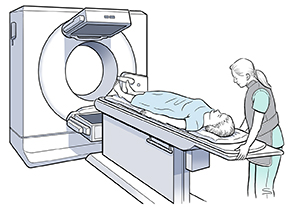Gastric Emptying Scan
Gastric Emptying Scan

Before the test
Let your healthcare provider know of any medicines you’re taking. This includes vitamins, herbs, and over-the-counter medicines. Certain medicines may need to be stopped for a time in the days before the test.
Don’t eat or drink anything starting from 6 hours before the test.
Follow any other instructions given by your healthcare provider.
Let the technologist know
For your safety, let the technologist know if you:
Are taking any medicines
Had recent X-rays or tests involving other substances, such as barium
Have current symptoms of nausea or vomiting
Had recent surgery
Have other health problems, such as diabetes
Have any allergies
Are pregnant or may be pregnant
Are breastfeeding
During the test
A gastric emptying scan takes place in a hospital or imaging center. It is done by a technologist trained in nuclear medicine or radiology.
You’ll be given a meal to eat. This can be a solid food, such as eggs, or a liquid, such as water. Both the food and drink contain a small amount of tracer. The tracer has no flavor. If you’re allergic to the food to be given, another type of food is used instead.
After you finish the meal, you’ll be asked to lie on your back on an exam table.
Pictures of your stomach are then taken with a machine called a scanner. You must lie still during this process. The scanner uses technology that can detect the amount of tracer in the stomach. As food is emptied from the stomach, the amount of tracer decreases. This allows the technologist to measure the rate at which food is leaving the stomach.
More pictures of your stomach are taken at different times. This usually occurs after 1, 2, and 4 hours of eating the meal. You can leave the room between the times the pictures are taken. But do not eat or drink anything or perform any strenuous activities during this period.
Once the last set of pictures has been taken, the test is complete.
After the test
You can go home shortly after the test. A nuclear medicine doctor or radiologist will communicate the test results to your healthcare provider. Your provider will then review the test results with you. This will likely occur within a few days of the test.
Risks and possible complications of this test
There is a small amount of radiation exposure from the tracer. This amount is not considered to be dangerous, but it can carry certain risks if you are pregnant or breastfeeding. Be sure to talk to your healthcare provider about these risks before the test.
Updated:
June 26, 2018
Reviewed By:
Grossman, Neil, MD,Image reviewed by StayWell medical illustration team.,Sather, Rita, RN